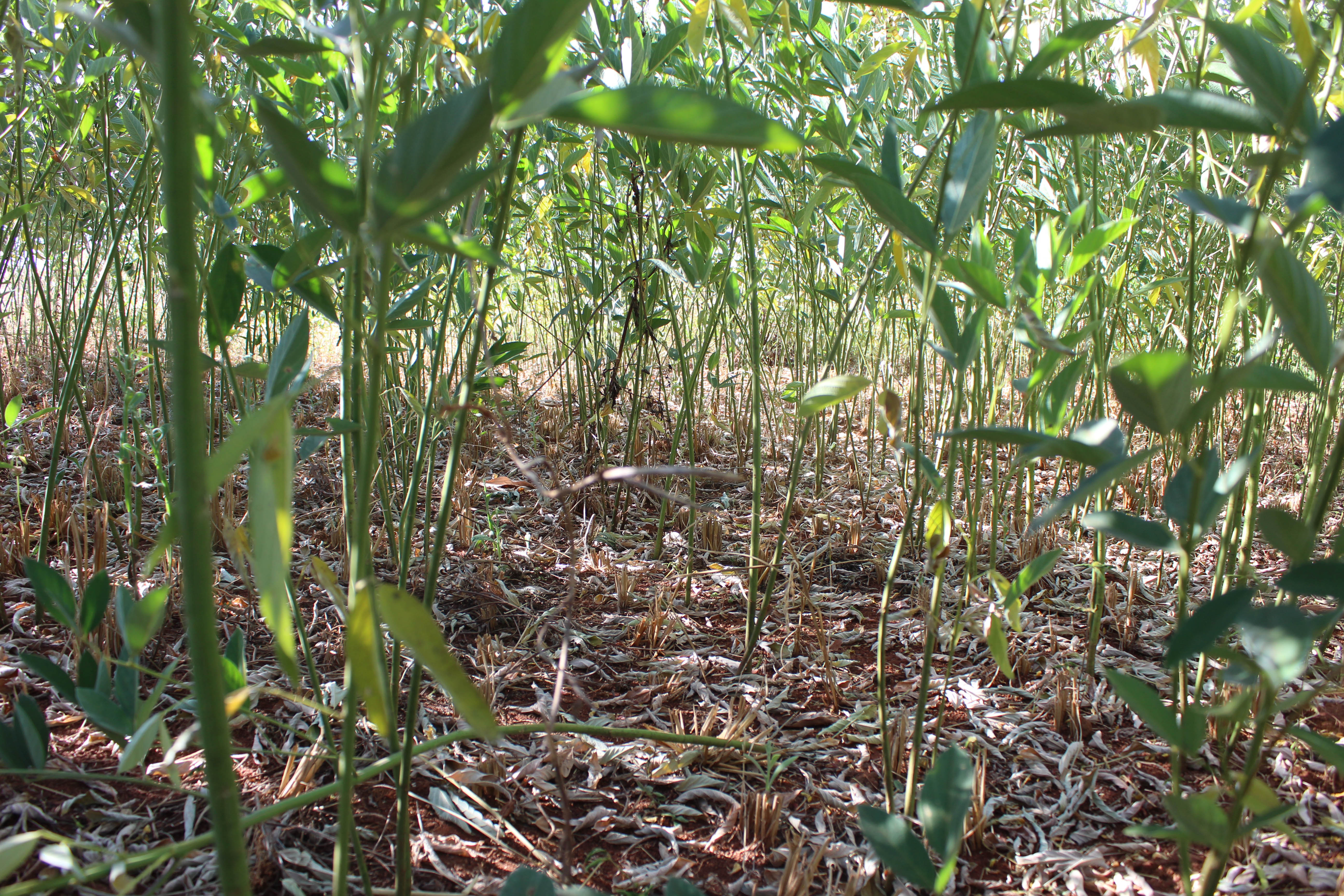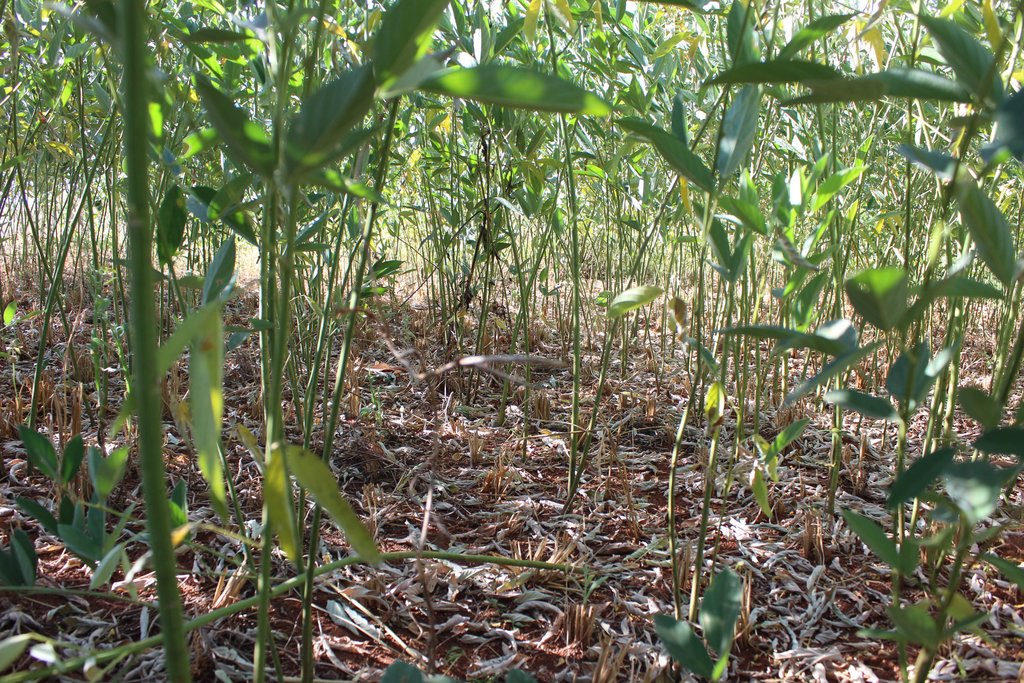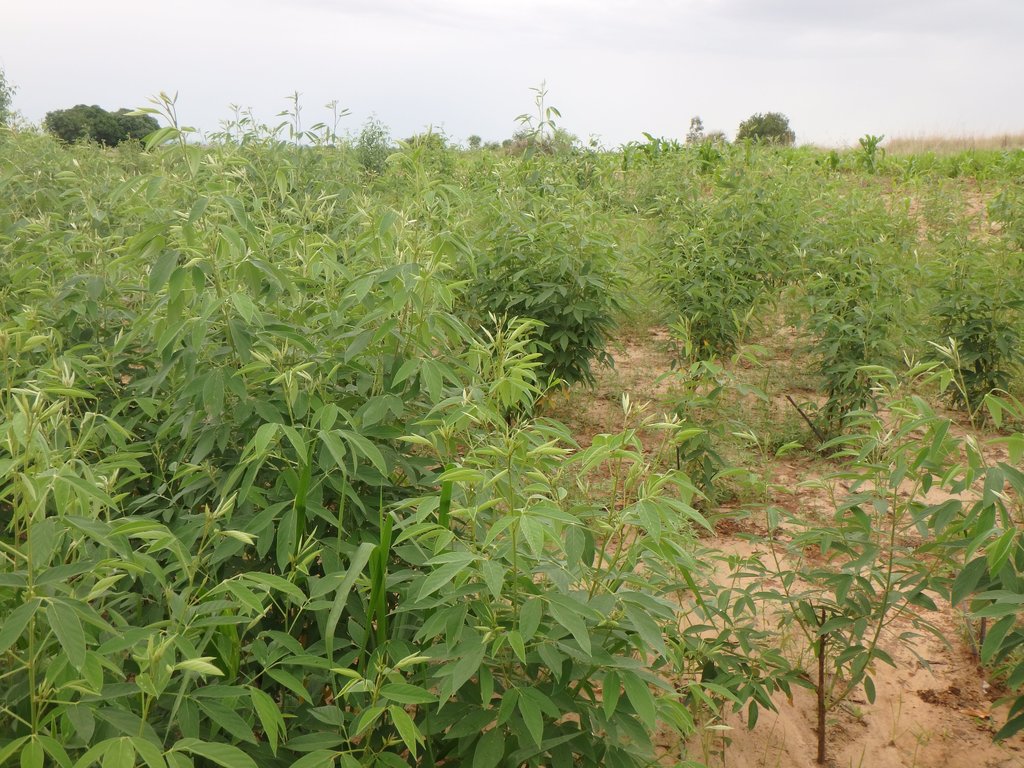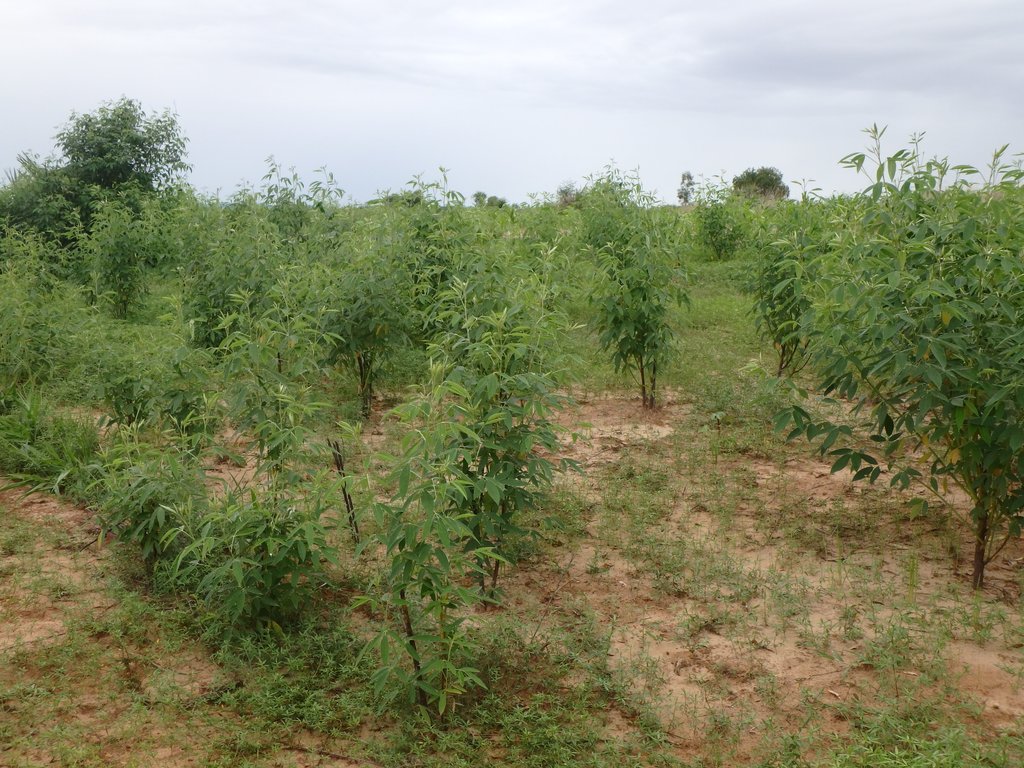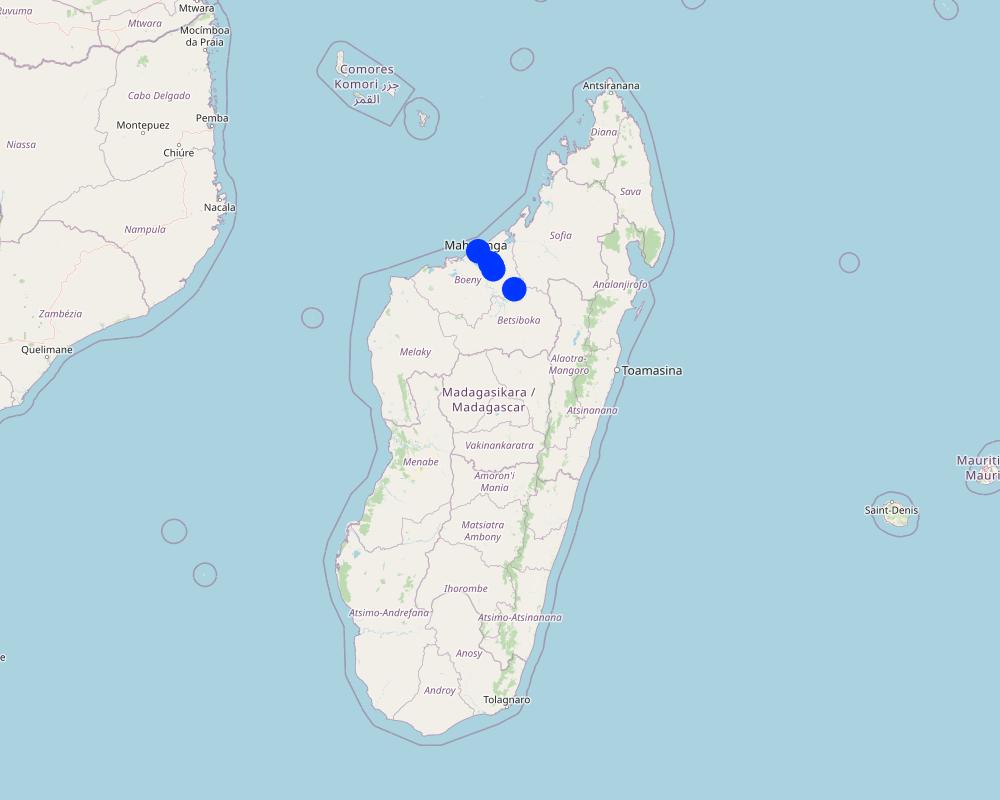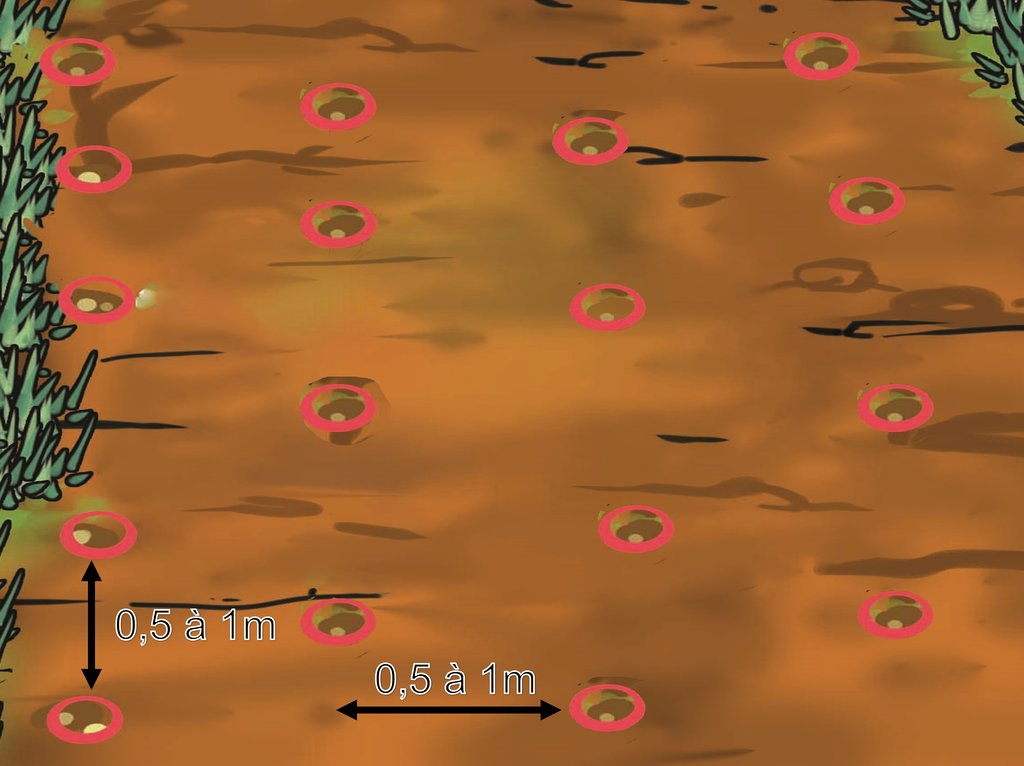Soil Regeneration through Cajanus cajan (pigeon pea) mini-forests [Madagascar]
- Creation:
- Update:
- Compiler: Harifidy RAKOTO RATSIMBA
- Editors: Felana Nantenaina RAMALASON, Dimby RAHERINJATOVOARISON, Siagbé Golli, Tahiry Ravivonandrasana, Natacha Rabeary, Tabitha Nekesa, Ahmadou Gaye
- Reviewers: William Critchley, Rima Mekdaschi Studer
Fanatsarana tany amin'ny fambolena alan'ambatry
technologies_6481 - Madagascar
View sections
Expand all Collapse all1. General information
1.2 Contact details of resource persons and institutions involved in the assessment and documentation of the Technology
Key resource person(s)
land user:
RAFARAMALALA Denise Germaine
Madagascar
land user:
FERDINAND
Madagascar
land user:
MAKA
Madagascar
land user:
RALAIMIDONA Jocelyn Jean Chrystophe
Madagascar
land user:
RANDRIANANDRASANA Tsimihery Jean
Madagascar
Name of project which facilitated the documentation/ evaluation of the Technology (if relevant)
Soil protection and rehabilitation for food security (ProSo(i)l)Name of the institution(s) which facilitated the documentation/ evaluation of the Technology (if relevant)
Deutsche Gesellschaft für Internationale Zusammenarbeit (GIZ)1.3 Conditions regarding the use of data documented through WOCAT
The compiler and key resource person(s) accept the conditions regarding the use of data documented through WOCAT:
Yes
1.4 Declaration on sustainability of the described Technology
Is the Technology described here problematic with regard to land degradation, so that it cannot be declared a sustainable land management technology?
No
2. Description of the SLM Technology
2.1 Short description of the Technology
Definition of the Technology:
Cajanus cajan, commonly known as pigeon pea, is a perennial shrub legume that thrives in nutrient-deficient soils and exhibits resilience to water scarcity. Cultivating pigeon pea contributes to the rejuvenation of impoverished soils through fixing atmospheric nitrogen and its leaf litter, while concurrently yielding food, fodder, and fuelwood.
2.2 Detailed description of the Technology
Description:
Cajanus cajan, commonly known as pigeon pea, is a perennial shrub legume that thrives in nutrient-deficient soils and exhibits resilience to water scarcity. Pigeon pea can be grown on depleted or infertile soils, both on gently sloping plots and in non-flooded lowlands. Sowing takes place at the onset of the rainy season. If the farmer's priority is to restore soil fertility, the recommended plant spacing is 50 cm within and between rows, with two seeds per seed hole, totalling 20 kg of seed per hectare. If the adopter wishes to harvest the maximum number of seeds for consumption, it is recommended to increase the spacing between rows to 1m, resulting in a seed quantity of 10 kg/ha. In both cases, it is advisable to sow the plants in staggered rows and conduct weeding around the seedlings at the initial stages of cultivation.
At the start of the second rainy season, the plants are pruned to a height of 40 cm, and the prunings are spread on the ground or partly used for animal feed. The wood collected can also be used as firewood. If the biomass is well developed, every other row can be cut to increase seed production. From the third year onwards, it is generally possible to thin the mini-forest further and reintroduce low-demand crops such as cassava.
One of the advantages of this technology is the restoration of soil fertility. Being a legume, pigeon pea fixes nitrogen from the atmosphere. Furthermore, through the extensive burrowing of taproots, essential mineral elements are retrieved from deep within the soil and brought back to the surface in the form of abundant litter. This process promotes the revival of biological activity in the soil. Pigeon pea cover also curbs surface erosion. With this technology, it is possible to produce edible seeds, animal fodder and firewood.
2.3 Photos of the Technology
2.5 Country/ region/ locations where the Technology has been applied and which are covered by this assessment
Country:
Madagascar
Region/ State/ Province:
Boeny
Further specification of location:
Ambalakida, Belobaka, Ambondromamy, Marovoay Banlieue, Antanambao Andranolava
Specify the spread of the Technology:
- evenly spread over an area
If precise area is not known, indicate approximate area covered:
- < 0.1 km2 (10 ha)
Is/are the technology site(s) located in a permanently protected area?
No
Map
×2.6 Date of implementation
Indicate year of implementation:
2020
If precise year is not known, indicate approximate date:
- less than 10 years ago (recently)
2.7 Introduction of the Technology
Specify how the Technology was introduced:
- through projects/ external interventions
Comments (type of project, etc.):
GIZ ProSoil Madagascar
3. Classification of the SLM Technology
3.1 Main purpose(s) of the Technology
- improve production
- reduce, prevent, restore land degradation
- protect a watershed/ downstream areas – in combination with other Technologies
- create beneficial economic impact
3.2 Current land use type(s) where the Technology is applied
Land use mixed within the same land unit:
No

Cropland
- Perennial (non-woody) cropping
- Pigeon pea (Cajanus)
Number of growing seasons per year:
- 1
Is intercropping practiced?
No
Is crop rotation practiced?
Yes
If yes, specify:
Following three years of pigeon pea cultivation, a crop rotation strategy can be implemented. Cereals such as rice, sorghum, maize, etc., can be introduced in combination with legumes. Subsequently, cassava can be integrated into the rotation plan. After this sequence, the cycle recommences with a three-year replanting of pigeon peas.
3.3 Has land use changed due to the implementation of the Technology?
Has land use changed due to the implementation of the Technology?
- Yes (Please fill out the questions below with regard to the land use before implementation of the Technology)
Land use mixed within the same land unit:
No

Cropland
- Annual cropping
Annual cropping - Specify crops:
- cereals - maize
- oilseed crops - groundnuts
Is intercropping practiced?
No
Is crop rotation practiced?
No

Unproductive land
Specify:
Savannah
Remarks:
These are grassy savannahs that farmers want to cultivate after 3 years of pigeon pea cultivation, given the legume's capacity to rejuvenate soil fertility, hence the change in land use.
3.4 Water supply
Water supply for the land on which the Technology is applied:
- rainfed
3.5 SLM group to which the Technology belongs
- rotational systems (crop rotation, fallows, shifting cultivation)
- improved ground/ vegetation cover
- integrated soil fertility management
3.6 SLM measures comprising the Technology

agronomic measures
- A1: Vegetation/ soil cover
- A2: Organic matter/ soil fertility

vegetative measures
- V1: Tree and shrub cover
- V2: Grasses and perennial herbaceous plants
3.7 Main types of land degradation addressed by the Technology

soil erosion by water
- Wt: loss of topsoil/ surface erosion

soil erosion by wind
- Et: loss of topsoil

chemical soil deterioration
- Cn: fertility decline and reduced organic matter content (not caused by erosion)

biological degradation
- Bc: reduction of vegetation cover
3.8 Prevention, reduction, or restoration of land degradation
Specify the goal of the Technology with regard to land degradation:
- reduce land degradation
- restore/ rehabilitate severely degraded land
4. Technical specifications, implementation activities, inputs, and costs
4.1 Technical drawing of the Technology
Technical specifications (related to technical drawing):
For soil restoration, the advised spacing ranges from 50 cm to 1 m within and between rows, with variations based on soil fertility. Each seedbed is planted with 2 grains during sowing. Over the years, the density can be decreased by eliminating every other row. Starting from the third year, if there are noticeable signs of soil improvement, it is possible to grow food crops in alleyways.
Author:
GIZ ProSoil Madagascar
Date:
01/02/2023
4.2 General information regarding the calculation of inputs and costs
Specify how costs and inputs were calculated:
- per Technology area
Indicate size and area unit:
1 hectare
other/ national currency (specify):
ariary
If relevant, indicate exchange rate from USD to local currency (e.g. 1 USD = 79.9 Brazilian Real): 1 USD =:
4300.0
Indicate average wage cost of hired labour per day:
7500
4.3 Establishment activities
| Activity | Timing (season) | |
|---|---|---|
| 1. | Weeding of the field | September-October |
| 2. | Soil plowing (plow + harrow) | November-December |
| 3. | Seeding | December-January |
4.4 Costs and inputs needed for establishment
| Specify input | Unit | Quantity | Costs per Unit | Total costs per input | % of costs borne by land users | |
|---|---|---|---|---|---|---|
| Labour | Weeding of the field | man-days | 10.0 | 7500.0 | 75000.0 | 100.0 |
| Labour | Seeding | man-days | 20.0 | 7500.0 | 150000.0 | 100.0 |
| Equipment | Soil plowing (plow + harrow) | animal traction | 6.0 | 25000.0 | 150000.0 | 100.0 |
| Equipment | Machete | Number | 4.0 | 15000.0 | 60000.0 | 100.0 |
| Plant material | Pigeon pea seeds | kg | 20.0 | 4000.0 | 80000.0 | |
| Total costs for establishment of the Technology | 515000.0 | |||||
| Total costs for establishment of the Technology in USD | 119.77 | |||||
If land user bore less than 100% of costs, indicate who covered the remaining costs:
GIZ ProSol Madagascar
4.5 Maintenance/ recurrent activities
| Activity | Timing/ frequency | |
|---|---|---|
| 1. | Trimming/cutting | Once a year in December or January |
Comments:
Weeding is optional when pigeon pea is grown for soil restoration purposes.
4.6 Costs and inputs needed for maintenance/ recurrent activities (per year)
| Specify input | Unit | Quantity | Costs per Unit | Total costs per input | % of costs borne by land users | |
|---|---|---|---|---|---|---|
| Labour | Trimming/cutting | man-days | 4.0 | 7500.0 | 30000.0 | 100.0 |
| Total costs for maintenance of the Technology | 30000.0 | |||||
| Total costs for maintenance of the Technology in USD | 6.98 | |||||
4.7 Most important factors affecting the costs
Describe the most determinate factors affecting the costs:
Labour for implementation
5. Natural and human environment
5.1 Climate
Annual rainfall
- < 250 mm
- 251-500 mm
- 501-750 mm
- 751-1,000 mm
- 1,001-1,500 mm
- 1,501-2,000 mm
- 2,001-3,000 mm
- 3,001-4,000 mm
- > 4,000 mm
Specify average annual rainfall (if known), in mm:
1400.00
Agro-climatic zone
- sub-humid
5.2 Topography
Slopes on average:
- flat (0-2%)
- gentle (3-5%)
- moderate (6-10%)
- rolling (11-15%)
- hilly (16-30%)
- steep (31-60%)
- very steep (>60%)
Landforms:
- plateau/plains
- ridges
- mountain slopes
- hill slopes
- footslopes
- valley floors
Altitudinal zone:
- 0-100 m a.s.l.
- 101-500 m a.s.l.
- 501-1,000 m a.s.l.
- 1,001-1,500 m a.s.l.
- 1,501-2,000 m a.s.l.
- 2,001-2,500 m a.s.l.
- 2,501-3,000 m a.s.l.
- 3,001-4,000 m a.s.l.
- > 4,000 m a.s.l.
Indicate if the Technology is specifically applied in:
- not relevant
5.3 Soils
Soil depth on average:
- very shallow (0-20 cm)
- shallow (21-50 cm)
- moderately deep (51-80 cm)
- deep (81-120 cm)
- very deep (> 120 cm)
Soil texture (topsoil):
- coarse/ light (sandy)
- medium (loamy, silty)
Soil texture (> 20 cm below surface):
- medium (loamy, silty)
Topsoil organic matter:
- medium (1-3%)
- low (<1%)
5.4 Water availability and quality
Ground water table:
5-50 m
Availability of surface water:
medium
Water quality (untreated):
poor drinking water (treatment required)
Water quality refers to:
ground water
Is water salinity a problem?
No
Is flooding of the area occurring?
No
5.5 Biodiversity
Species diversity:
- medium
Habitat diversity:
- low
Comments and further specifications on biodiversity:
This region boasts a diverse array of plant and animal species, with some being native. However, this biodiversity is relatively moderate when compared to other parts of the island. In terms of habitats, approximately 20% of the region comprises suitable environments for supporting this biodiversity, including forests, water bodies, mangroves, and more, although this percentage remains relatively low.
5.6 Characteristics of land users applying the Technology
Sedentary or nomadic:
- Sedentary
Market orientation of production system:
- mixed (subsistence/ commercial)
Off-farm income:
- 10-50% of all income
Relative level of wealth:
- average
Individuals or groups:
- individual/ household
- groups/ community
Level of mechanization:
- manual work
Gender:
- women
- men
Age of land users:
- youth
- middle-aged
5.7 Average area of land used by land users applying the Technology
- < 0.5 ha
- 0.5-1 ha
- 1-2 ha
- 2-5 ha
- 5-15 ha
- 15-50 ha
- 50-100 ha
- 100-500 ha
- 500-1,000 ha
- 1,000-10,000 ha
- > 10,000 ha
Is this considered small-, medium- or large-scale (referring to local context)?
- medium-scale
5.8 Land ownership, land use rights, and water use rights
Land ownership:
- individual, not titled
- individual, titled
Land use rights:
- individual
Water use rights:
- open access (unorganized)
Are land use rights based on a traditional legal system?
Yes
Specify:
The lands are owned by those taking care of them
5.9 Access to services and infrastructure
health:
- poor
- moderate
- good
education:
- poor
- moderate
- good
technical assistance:
- poor
- moderate
- good
employment (e.g. off-farm):
- poor
- moderate
- good
markets:
- poor
- moderate
- good
energy:
- poor
- moderate
- good
roads and transport:
- poor
- moderate
- good
drinking water and sanitation:
- poor
- moderate
- good
financial services:
- poor
- moderate
- good
6. Impacts and concluding statements
6.1 On-site impacts the Technology has shown
Socio-economic impacts
Production
crop production
crop quality
Income and costs
expenses on agricultural inputs
farm income
workload
Socio-cultural impacts
food security/ self-sufficiency
Ecological impacts
Water cycle/ runoff
surface runoff
Soil
soil moisture
Biodiversity: vegetation, animals
Vegetation cover
biomass/ above ground C
Specify assessment of on-site impacts (measurements):
These are estimates provided by the farmers.
6.2 Off-site impacts the Technology has shown
downstream siltation
Comments/ specify:
The reduction in downstream rice field siltation is a positive outcome.
damage on neighbours' fields
Specify assessment of off-site impacts (measurements):
These are estimates provided by the farmers.
6.3 Exposure and sensitivity of the Technology to gradual climate change and climate-related extremes/ disasters (as perceived by land users)
Gradual climate change
Gradual climate change
| Season | increase or decrease | How does the Technology cope with it? | |
|---|---|---|---|
| annual temperature | increase | not well | |
| annual rainfall | decrease | moderately |
Climate-related extremes (disasters)
Meteorological disasters
| How does the Technology cope with it? | |
|---|---|
| tropical storm | moderately |
Biological disasters
| How does the Technology cope with it? | |
|---|---|
| insect/ worm infestation | not well |
6.4 Cost-benefit analysis
How do the benefits compare with the establishment costs (from land users’ perspective)?
Short-term returns:
slightly negative
Long-term returns:
positive
How do the benefits compare with the maintenance/ recurrent costs (from land users' perspective)?
Short-term returns:
slightly negative
Long-term returns:
positive
6.5 Adoption of the Technology
- single cases/ experimental
6.6 Adaptation
Has the Technology been modified recently to adapt to changing conditions?
No
6.7 Strengths/ advantages/ opportunities of the Technology
| Strengths/ advantages/ opportunities in the land user’s view |
|---|
| The soil is regenerated and partially protected against surface water and wind erosion. Crop production increases after the pigeon pea crop has been removed from the plot. |
| Additional income generated by seed sales. Part of the production is also food and firewood for farmers. |
| Strengths/ advantages/ opportunities in the compiler’s or other key resource person’s view |
|---|
| With respect to soil restoration, no treatment is necessary and the amount of work required is minimal. |
| Once implemented, there is no need to work on the plot for 2 to 3 years, except to harvest peas and wood. |
6.8 Weaknesses/ disadvantages/ risks of the Technology and ways of overcoming them
| Weaknesses/ disadvantages/ risks in the land user’s view | How can they be overcome? |
|---|---|
| Certain individuals remain unconvinced about the advantages of technology, leading to a sense of discouragement. | Increased practice and awareness |
| Weaknesses/ disadvantages/ risks in the compiler’s or other key resource person’s view | How can they be overcome? |
|---|---|
|
Pigeon pea cultivation is fairly vulnerable to insects, which cause damage on the pods. |
Apply efficient treatments (which is time consuming, expensive and deterimental to the environment if they are pesticides). Ensure there is a fair distance between the pigeon pea cultivation areas and avoid the legume cropping areas. |
| At present, there are no significant commercial avenues for this crop. Consequently, farmers predominantly cultivate pigeon peas for self-consumption, restricting their ability to engage in large-scale cultivation. | Focus on promoting and marketing this species to transform it into a potential source of supplementary income. |
7. References and links
7.1 Methods/ sources of information
- field visits, field surveys
Five (5) fields visited
- interviews with land users
Five (5) farmers interviewed
- compilation from reports and other existing documentation
GIZ ProSoil Madagascar technical sheet
When were the data compiled (in the field)?
01/31/2023
7.2 References to available publications
Title, author, year, ISBN:
Région Boeny, 2016, "Schéma Régional d’Aménagement du Territoire de la Région Boeny"
Available from where? Costs?
Boeny Region Hotel
Title, author, year, ISBN:
GIZ ProSol Madagascar, 2020, Poster "Pois d’Angole"
Available from where? Costs?
GIZ ProSol Madagascar
Title, author, year, ISBN:
GIZ ProSol Benin, 2018, "Manuel de l’agriculteur"
Available from where? Costs?
GIZ ProSol Benin
Title, author, year, ISBN:
GRET, 2015, "Pratiques agroécologiques et agroforestières en zone tropicale humide", Fiche N°7 Jachère améliorée
Available from where? Costs?
https://gret.org/publication/pratiques-agroecologiques-et-agroforestieres-en-zone-tropicale-humide/
Links and modules
Expand all Collapse allLinks
No links
Modules
No modules


